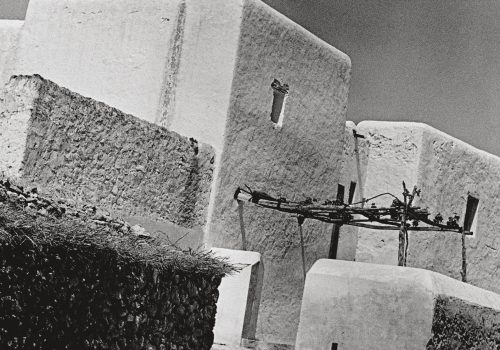Previously shown at the Point du Jour, the magnificent retrospective of Raoul Hausmann’s work comes to Jeu de Paume in Paris. Created by the exhibition curator and art historian Cécile Bargues, the exhibition surveys, among others, the Austro-Czechoslovakian photographer’s exciting research on the rural architecture and interiors of Ibiza.
In 1933, Nazi Germany published a list of “degenerate” artists. Raoul Hausmann ranked thirteen. He and his partner, Vera Broïdo, left for Ibiza. The Balearic island had not yet been overtaken by the party spirit, brought on by the industrialization of pleasure (Yves Michaud). Hausmann arrived well before the tourist invasion of the 1950s and a good twenty years before the hippies congregated in search of nirvana in the 1960s. German tourists, including some Nazi sympathizers, were among the residents of the only hotel in the city. The philosopher Walter Benjamin would find refuge on the island. Hausmann left all this gentle madness behind; he spent his time almost exclusively with Ibiza’s residents, most of them peasants.
The territory and the photographer’s friendly relationship with the locals offer a unique window on the architecture and the customs of the island. An intuitive understanding takes shape: the fincas and their interiors represent classic perfection, a melting pot of European architectures. Hausmann identified an “architecture without an architect.” In Ibiza, the traditional, whitewashed houses were passed on by oral transmission.
By studying their layouts and drawing them with precision, Hausmann was able to pinpoint the similarities between the different houses. Very often, a central living room would directly adjoin several bedrooms. Larger houses opened onto vast terraces overlooking the fields below. There were few windows so as to keep the interiors cool.
Hausmann’s study further allowed him to understand how much fincas, their exterior decorations and their indoor furnishings were a product of several waves of migration. In the finca, we find elements of Mediterranean architecture, specifically the rounded forms of Greek houses, as well as the minimalist Arabic hierarchies.
While Walker Evans stopped at façades, and street photography in his time didn’t venture indoors, Hausmann would circle the house, go inside, talk to and learn from the peasants. The building wasn’t everything. He wrote about his discoveries, but without formulating any theories. He was happy simply observing. In his writings, he never took sides, but described the local customs. In this, he was unlike Le Corbusier who “looked toward Athens and sought a typical Mediterranean house,” explains Cécile Bargues.
In this respect, the fincas are “stateless” habitations: they are the fruit of several migrations, of a rural tradition transmitted by word of mouth, and they promote nothing, except perhaps simplicity and usefulness. By affirming this hybridity, Hausman “dismantles the ideas of the Fascist propaganda and rejects the idea of racial ‘purity’—an idea according to which a given race is expressed in a given type of architecture and art,” explains Cécile Bargues. Hausmann asserted that no one people were better than another; there was no such thing as national superiority—there were simply civilizational encounters. When it was first expressed in Switzerland, Hausmann’s philosophy earned him to be denounced.
The period of calm and study in Ibiza came to an abrupt end with the outbreak of the civil war in Spain. In Ibiza, the fighting lasted only a month. The island was defeated and taken over by Franco’s forces. Raoul Hausmann’s misfortunes had barely begun.
Arthur Dayras
Raoul Hausmann: Vision in Action
February 6 to May 20, 2018
Jeu de Paume
1 Place de la Concorde
75008 Paris
France
















